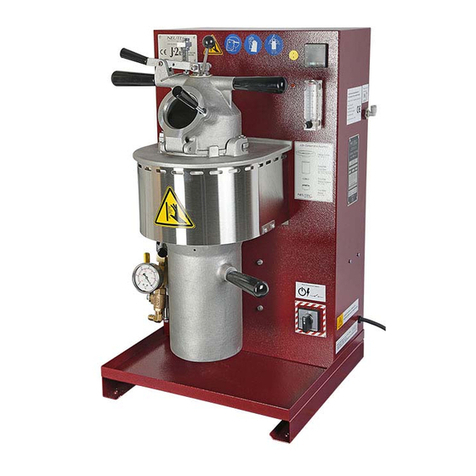
page 3
800.545.6566 www.riogrande.com
V.I.C™9 Tabletop Casting Machine
General Safety Precautions
Investing and casting are processes that require
forethought and precautions. Planning for every step
of the investing and casting processes in your shop is a
responsibility you owe to yourself and your co-workers.
Safety precautions and protective attire are a must
for investing, melting and casting.
• Wear protective clothing and eyewear when investing
and casting. Proper safety precautions should always be
taken.
• Molten metal will cause severe burns and can start fires.
Make sure no flammable materials are near the casting
area.
• Plan a place to put the hot flask after casting where you
nor anyone else can accidentally come in contact with it.
Remember, flasks with temperatures of several hundred
degrees look the same as cold flasks.
• If you have a helper, plan the actions both of you will
take during your casting process before you begin.
• Keep close watch on the torch flame. It can burn
something or someone from quite a distance. Take care
not to melt your bell jar. If you do, replace it right away.
The bell jar is not safe if it has been cracked, scratched or
damaged by a torch flame or molten metal.
• Never push on the top of the bell jar while it is under
vacuum. When a bell jar breaks, it first implodes and
then explodes, sending sharp pieces of shattered plastic
around the room. To ensure a good seal, check to make
sure the pad under the bell jar is clean and free of dirt
or debris, then gently press the rim of the bell jar
securely against the rubber investing pad when vacuum
is first applied.
•WARNING:Investment powder contains free silica. Inhal-
ing silica is dangerous and may cause progressive, irrevers-
ible lung injury over time. Always wear a respirator appropri-
ate for use with investment when investing and quenching
flasks, and completely clean up investment from your work
area. Wear an OSHA approved respirator during investing
processes and work in a well-ventilated space with a draft
that pulls air away from you when handling investment pow-
der. Never use a vacuum cleaner unless it is designed to pick
up respirable silica (particles as fine as 5 microns).
Please read, understand and follow all of the safety
recommendations offered on the MSDS available with your
investment product.
Please Note:Visit riogrande.com or see your Rio Grande Tools
& Equipment catalog for all the proper safety accessories—
including eyewear, gloves, aprons, masks, and respirators
recommended •for investing, metal-melting and casting, as
well as safety equipment for your entire shop.
Investing
CAUTION: Always test the vacuum seal between the jar
and pad before mixing investment. To test the vacuum
seal, moisten the underside of the bell jar rim with a clean
sponge. Place the bell jar over the vacuum table and rubber
vacuum pad. If needed, apply slight pressure around the
rim of the jar. Never apply pressure to the top of the bell jar.
NEVER push down on the top of the bell jar under vacuum.
This can cause the bell jar to break and implode.
Preparation
Prepare flasks to be invested. For consistent casting results,
use Wax Web™ (see page 8) in every flask.
Using Wax Web™
Wax Web is a clean-burning wax mesh that increases the
efficiency of vacuum casting. Because Wax Web creates a
network of gas evacuation channels around the inside of
your flask, it directs the power of the vacuum equally
around the perimeter of the mold. It’s simple to use!
1. Roll the Wax Web sheet into a cylinder and position it
flush with the inside top of the flask. Wax Web should
not extend more than 70%–80% along the inside of
the flask. Trim it if necessary.
2. Secure Wax Web in place with bobby pins or melt it
to the flask at several points with a heated wax tool.
3. As you build your sprue tree, always allow at least 1/2"
of space between the top of the wax patterns and the
level of investment in the flask (perhaps more for large
or heavy items). Please Note: Because a 1/8"gap should
always be left between the investment level and the
top lip of the flask for a good seal when casting, the top
of your sprue tree should never be closer than 5/8"to
the top of the flask. This precaution, along with strictly
controlled investing procedures, will help prevent flask
blowouts.



























